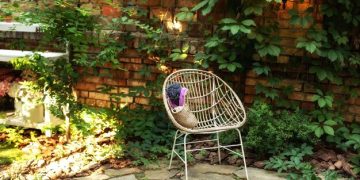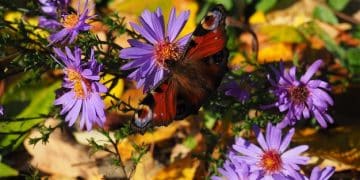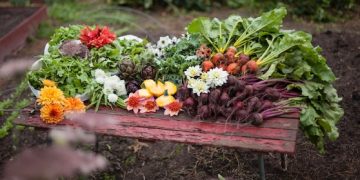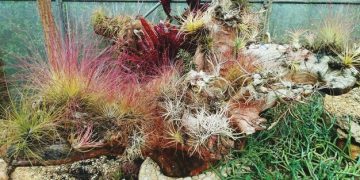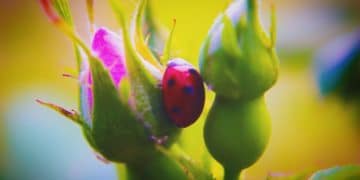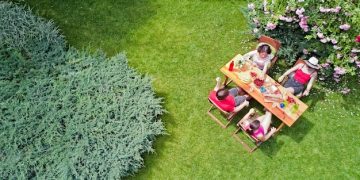Create a Butterfly Garden: Attract Monarchs Easily
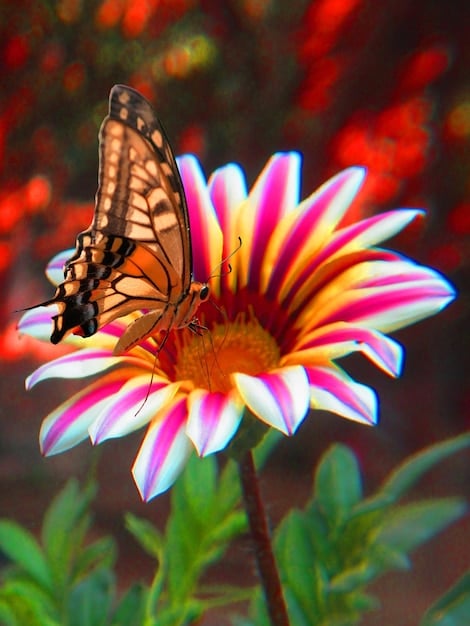
Creating a butterfly garden involves selecting specific plants that attract Monarch butterflies by providing food for caterpillars and nectar for adult butterflies, enhancing garden biodiversity.
Want to create a butterfly garden that Monarchs will adore? It’s easier than you think! By selecting the right plants, you can transform your backyard into a haven for these beautiful creatures.
Why Create a Butterfly Garden for Monarchs?
Creating a butterfly garden specifically for Monarchs isn’t just a visually appealing project; it’s a vital contribution to the conservation of this iconic species. Monarch butterfly populations have been declining, primarily due to habitat loss and the decrease of their crucial food source, milkweed.
By designing your garden to cater to their needs, you’re offering a sanctuary where they can feed, mate, and lay eggs. This small act can significantly impact the Monarch’s survival and contribute to a healthier ecosystem in your area.
The Declining Monarch Population
Understanding the challenges Monarch butterflies face is essential to appreciating the importance of butterfly gardens. Habitat loss, pesticide use, and climate change have all contributed to the significant decrease in Monarch populations over the past few decades.
Monarchs rely on milkweed plants as their sole food source during their larval stage. With habitat destruction, milkweed is becoming scarce, creating a food shortage for Monarch caterpillars.
Benefits of a Monarch Butterfly Garden
- Conservation: Provides essential resources that aid in Monarch conservation.
- Educational: Raises awareness about pollinators and teaches valuable ecological lessons.
- Aesthetic: Enhances the beauty of your garden with vibrant butterflies.
- Ecological: Supports local biodiversity and the health of the ecosystem.
Creating a Monarch butterfly garden involves choosing specific plants that provide food for caterpillars (host plants) and nectar for adult butterflies (nectar plants). By offering both of these resources, you’re creating a complete habitat for Monarchs within your own backyard.
Essential Host Plants for Monarch Caterpillars
If you’re serious about attracting Monarchs, you absolutely must include host plants in your garden. Host plants are the food that Monarch caterpillars rely on to grow and develop. As mentioned before, milkweed is the only host plant Monarch caterpillars can eat.
Selecting and growing the right milkweed species is crucial, and understanding the different varieties and what makes them suitable for your local climate is important for success.
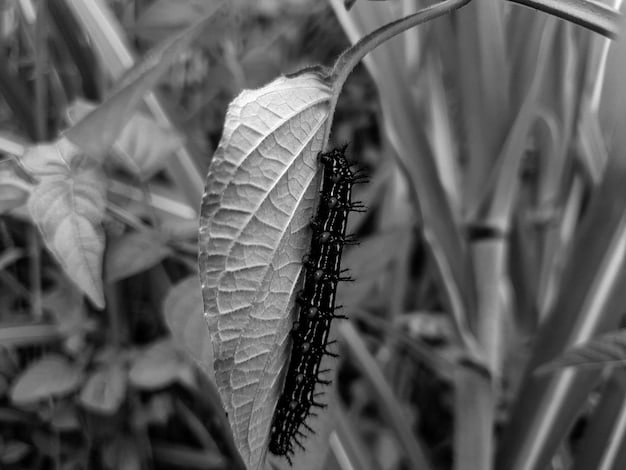
Types of Milkweed
Milkweed (Asclepias spp.) is the cornerstone of a Monarch butterfly garden. There are various species of milkweed, each with its own characteristics. Here are a few popular options:
- Common Milkweed (Asclepias syriaca): Suitable for larger gardens due to its spreading nature.
- Swamp Milkweed (Asclepias incarnata): Prefers moist soil and attracts a variety of butterflies.
- Butterfly Weed (Asclepias tuberosa): Drought-tolerant and offers bright orange flowers.
- Showy Milkweed (Asclepias speciosa): Native to the Western U.S. and has large, fragrant flower clusters.
When choosing your milkweed, consider conditions and whether or not the plant is native to your area. Native plants generally thrive better and provide better support to local butterfly populations.
Tips for Growing Milkweed
Growing milkweed can be easy, but there are a few factors to consider:
First, provide adequate sunlight. Most milkweed species require at least six hours of sunlight per day. Milkweed also needs well-drained soil. Avoid overwatering to prevent root rot.
Finally, avoid using pesticides, as they can harm or kill Monarch caterpillars and other beneficial insects.
By carefully selecting and growing milkweed, you’re creating a critical resource for Monarch caterpillars and contributing to their survival. Remember to monitor your plants for caterpillars and enjoy watching them grow!
Nectar Plants: A Feast for Adult Monarchs
Nectar plants provide the energy adult Monarch butterflies need to fly, mate, and lay eggs. While milkweed is essential for caterpillars, nectar plants are equally important for adult Monarchs.
Choosing nectar plants that bloom at different times throughout the season is important to ensure a continuous food source for visiting butterflies. A variety of plants with different flower shapes and colors will attract larger numbers of Monarchs and other pollinators to your garden.
Top Nectar Plants
Here are some excellent nectar plants to include in your Monarch butterfly garden:
- Zinnia (Zinnia elegans): Easy to grow and offers a wide range of colors.
- Lantana (Lantana camara): Provides clusters of vibrant flowers and attracts many butterflies.
- Purple Coneflower (Echinacea purpurea): A native plant that’s drought-tolerant and provides long-lasting blooms.
- Salvia (Salvia spp.): Attracts butterflies and hummingbirds with its tall flower spikes.
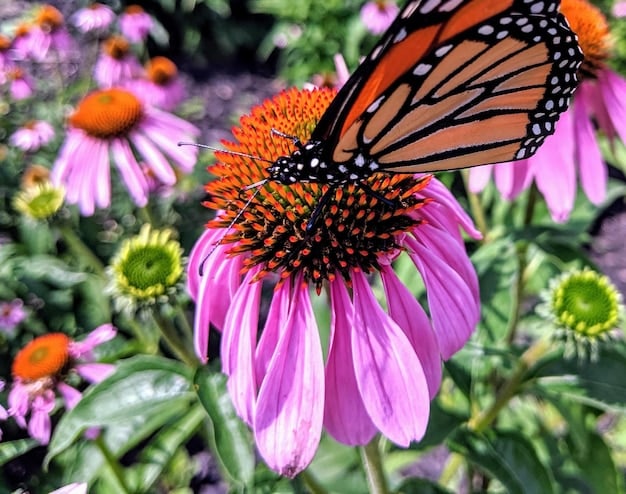
Designing Your Nectar Plant Arrangement
When arranging your nectar plants, consider the height and spread of each plant. Place taller plants towards the back of your garden and shorter plants in the front to ensure all plants receive adequate sunlight. Group plants together to create larger masses of color, which are more attractive to butterflies.
Also, ensure that you take into account bloom times. By having a wide variety of plants that bloom from early spring through late fall, you provide a consistent food source throughout the Monarchs’ active season.
A butterfly garden is a dynamic landscape that evolves throughout the seasons, offering continuous beauty and ecological benefits.
Location, Location, Location: Site Considerations
Where you choose to locate your butterfly garden is just as critical as the plants you select. Butterflies, like all living things, have specific needs for survival, and the right location can dramatically increase the success of your garden.
Considering factors such as sunlight, shelter, and access to water is crucial for creating a welcoming habitat that Monarch butterflies will want to return to, year after year.
Sunlight Requirements
Butterflies are cold-blooded and need sunlight to warm their bodies. Choose a location that receives at least six hours of direct sunlight per day. A sunny location will also help your plants thrive and produce abundant nectar.
Shelter from Wind
Strong winds can make it difficult for butterflies to fly and feed. Create a sheltered environment by planting shrubs or trees on the windward side of your garden. A fence or wall can also provide effective wind protection.
Water Source
Butterflies need water to stay hydrated. Provide a shallow dish of water with pebbles or marbles for them to land on. This will prevent them from drowning. You can also create a “butterfly puddle” by sinking a shallow dish into the ground and filling it with water and sand.
Your butterfly garden should also be accessible, so that you can easily observe and enjoy the butterflies you attract.
Maintenance and Care for a Thriving Garden
Maintaining your butterfly garden is crucial for ensuring that it continues to thrive and support Monarch butterflies. A well-maintained garden not only looks more appealing, but it also provides a healthier and more sustainable habitat for butterflies and other pollinators.
Regular watering, weeding, and proper plant care are essential for keeping your garden in top condition. With a little attention and effort, you can keep your butterfly garden flourishing for years to come.
Watering
Water your plants regularly, especially during dry spells. Water deeply to encourage strong root growth. Avoid overhead watering, as it can damage delicate butterfly wings and wash away nectar.
Weeding
Keep your garden free of weeds, as they can compete with your plants for resources. Hand-pull weeds to avoid using herbicides, which can harm butterflies and other beneficial insects.
Pruning and Deadheading
Prune your plants regularly to encourage new growth and prolong the bloom season. Remove dead or faded flowers (deadheading) to encourage plants to produce more blooms. This will keep your garden looking tidy and attractive to butterflies.
Your butterfly garden can become a self-sustaining ecosystem with minimal intervention, promoting a vibrant and healthy habitat for Monarchs and other pollinators.
Beyond the Basics: Additional Tips for Success
While selecting the right plants, location, and maintenance are fundamental, incorporating these additional tips can significantly enhance the success of your Monarch butterfly garden.
These extra steps help create an even more appealing and sustainable habitat, attracting more Monarchs and contributing to their conservation. With a bit of extra attention to detail, you can transform your garden into a truly special sanctuary for these magnificent creatures.
Avoid Pesticides
Never use pesticides in your butterfly garden. Pesticides can kill Monarch caterpillars and other beneficial insects. If you have pest problems, try using natural pest control methods, such as introducing beneficial insects or using insecticidal soap.
Provide a Roosting Spot
Butterflies need a place to rest and roost, especially at night. Provide a roosting spot by planting trees or shrubs with dense foliage. Butterflies will often gather together in these spots to sleep.
Join a Butterfly Conservation Program
Get involved in butterfly conservation efforts by participating in citizen science projects. You can help monitor butterfly populations and contribute to valuable research. Organizations like Monarch Watch and the North American Butterfly Association offer programs for butterfly enthusiasts.
With these extra measures, your garden can become a vital part of a larger effort to support and protect Monarch butterflies for generations.
| Key Point | Brief Description |
|---|---|
| 🌱 Milkweed | Essential host plant for Monarch caterpillars. |
| 🌸 Nectar Plants | Provide energy for adult Monarchs with plants like Zinnia and Lantana. |
| ☀️ Sunlight & Shelter | Ensure at least 6 hours of sunlight and protection from strong winds. |
| 💧 Water Source | Offer a shallow dish of water with pebbles for butterflies to hydrate. |
Frequently Asked Questions
▼
The best time to start a butterfly garden is in the spring or early summer, allowing plants to establish before butterfly season. This ensures host and nectar plants are ready for Monarchs.
▼
Water deeply but infrequently, allowing the soil to dry slightly between waterings. Adjust watering based on local climate and plant species’ specific needs to prevent over or underwatering.
▼
No, avoid using pesticides at all costs as they are harmful to butterflies, caterpillars, and other beneficial insects. Use natural pest control methods to maintain a healthy garden for Monarchs.
▼
If caterpillars consume all the milkweed, consider planting more, or relocate some caterpillars to other plants to avoid starvation. This balances the ecosystem’s needs and ensures caterpillar survival.
▼
Attract more Monarchs by planting a diverse array of both host (milkweed) and nectar-rich plants, providing a water source, and avoiding pesticide use in your garden area.
Conclusion
Creating a butterfly garden to attract Monarchs is both rewarding and crucial for supporting this iconic species. By selecting the right plants, providing a suitable environment, and practicing mindful gardening, you can create a beautiful and beneficial habitat for Monarchs in your own backyard. Each effort contributes to the conservation of Monarch butterflies and enhances local biodiversity.
